Natural language names
 | Bekleidung / Belag |
 | Covering |
 | Revêtement |
 | Bekleidung / Belag |
 | Covering |
 | Revêtement |
| Item | SPF | XML | Change | Description | IFC2x3 to IFC4 |
|---|---|---|---|---|
| IfcCovering | MOVED | Schema changed from IFCPRODUCTEXTENSION to IFCSHAREDBLDGELEMENTS. | ||
| OwnerHistory | MODIFIED | Instantiation changed to OPTIONAL. |
A covering is an element which covers some part of another element and is fully dependent on that other element. The IfcCovering defines the occurrence of a covering type, that (if given) is expressed by the IfcCoveringType.
NOTE Definition according to ISO ISO 6707-1: final coverings and treatments of surfaces and their intersections.
Coverings are elements with relationships to the covered element and the space on the other side, they may contain openings, assigned by IfcRelVoidsElement, material information, assigned by IfcRelAssociatesMaterial, and others.
EXAMPLE Coverings include wall claddings, floorings, suspended ceilings, moldings and skirting boards.
NOTE A more basic information about claddings, floorings, and ceilings of a space can be attached to IfcSpace's using the Pset_SpaceCommon properties. Then only a name can be provided and the covering quantities would be interpreted from the space quantities.
Coverings can be assigned to
NOTE The mere containment relationship between an IfcCovering and an IfcSpace is created by using IfcRelContainedInSpatialStructure
The following guideline shall apply:
HISTORY New entity in IFC1.0.
IFC2x CHANGE The attribute PredefinedType is now optional and should only be inserted when no type information, given by IfcCoveringType, is assigned to the IfcCovering occurrence by IfcRelDefinesByType.
| # | Attribute | Type | Cardinality | Description | C |
|---|---|---|---|---|---|
| 9 | PredefinedType | IfcCoveringTypeEnum | [0:1] |
Predefined types to define the particular type of the covering. There may be property set definitions available for each predefined type.
NOTE The PredefinedType shall only be used, if no IfcCoveringType is assigned, providing its own IfcCoveringType.PredefinedType. | X |
| CoversSpaces | IfcRelCoversSpaces @RelatedCoverings | S[0:1] | Reference to the objectified relationship that handles the relationship of the covering to the covered space. | X | |
| CoversElements | IfcRelCoversBldgElements @RelatedCoverings | S[0:1] | Reference to the objectified relationship that handles the relationship of the covering to the covered element. | X |
| Rule | Description |
|---|---|
| CorrectPredefinedType | Either the PredefinedType attribute is unset (e.g. because an IfcCoveringType is associated), or the inherited attribute ObjectType shall be given, if the PredefinedType is set to USERDEFINED. |
| CorrectTypeAssigned | Either there is no covering type object associated, i.e. the IsTypedBy inverse relationship is not provided, or the associated type object has to be of type IfcCoveringType. |
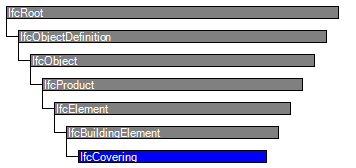
| # | Attribute | Type | Cardinality | Description | C |
|---|---|---|---|---|---|
| IfcRoot | |||||
| 1 | GlobalId | IfcGloballyUniqueId | [1:1] | Assignment of a globally unique identifier within the entire software world. | X |
| 2 | OwnerHistory | IfcOwnerHistory | [0:1] |
Assignment of the information about the current ownership of that object, including owning actor, application, local identification and information captured about the recent changes of the object,
NOTE only the last modification in stored - either as addition, deletion or modification. | X |
| 3 | Name | IfcLabel | [0:1] | Optional name for use by the participating software systems or users. For some subtypes of IfcRoot the insertion of the Name attribute may be required. This would be enforced by a where rule. | X |
| 4 | Description | IfcText | [0:1] | Optional description, provided for exchanging informative comments. | X |
| IfcObjectDefinition | |||||
| HasAssignments | IfcRelAssigns @RelatedObjects | S[0:?] | Reference to the relationship objects, that assign (by an association relationship) other subtypes of IfcObject to this object instance. Examples are the association to products, processes, controls, resources or groups. | X | |
| Nests | IfcRelNests @RelatedObjects | S[0:1] | References to the decomposition relationship being a nesting. It determines that this object definition is a part within an ordered whole/part decomposition relationship. An object occurrence or type can only be part of a single decomposition (to allow hierarchical strutures only). | X | |
| IsNestedBy | IfcRelNests @RelatingObject | S[0:?] | References to the decomposition relationship being a nesting. It determines that this object definition is the whole within an ordered whole/part decomposition relationship. An object or object type can be nested by several other objects (occurrences or types). | X | |
| HasContext | IfcRelDeclares @RelatedDefinitions | S[0:1] | References to the context providing context information such as project unit or representation context. It should only be asserted for the uppermost non-spatial object. | X | |
| IsDecomposedBy | IfcRelAggregates @RelatingObject | S[0:?] | References to the decomposition relationship being an aggregation. It determines that this object definition is whole within an unordered whole/part decomposition relationship. An object definitions can be aggregated by several other objects (occurrences or parts). | X | |
| Decomposes | IfcRelAggregates @RelatedObjects | S[0:1] | References to the decomposition relationship being an aggregation. It determines that this object definition is a part within an unordered whole/part decomposition relationship. An object definitions can only be part of a single decomposition (to allow hierarchical strutures only). | X | |
| HasAssociations | IfcRelAssociates @RelatedObjects | S[0:?] | Reference to the relationship objects, that associates external references or other resource definitions to the object.. Examples are the association to library, documentation or classification. | X | |
| IfcObject | |||||
| 5 | ObjectType | IfcLabel | [0:1] |
The type denotes a particular type that indicates the object further. The use has to be established at the level of instantiable subtypes. In particular it holds the user defined type, if the enumeration of the attribute PredefinedType is set to USERDEFINED.
| X |
| IsDeclaredBy | IfcRelDefinesByObject @RelatedObjects | S[0:1] | Link to the relationship object pointing to the declaring object that provides the object definitions for this object occurrence. The declaring object has to be part of an object type decomposition. The associated IfcObject, or its subtypes, contains the specific information (as part of a type, or style, definition), that is common to all reflected instances of the declaring IfcObject, or its subtypes. | X | |
| Declares | IfcRelDefinesByObject @RelatingObject | S[0:?] | Link to the relationship object pointing to the reflected object(s) that receives the object definitions. The reflected object has to be part of an object occurrence decomposition. The associated IfcObject, or its subtypes, provides the specific information (as part of a type, or style, definition), that is common to all reflected instances of the declaring IfcObject, or its subtypes. | X | |
| IsTypedBy | IfcRelDefinesByType @RelatedObjects | S[0:1] | Set of relationships to the object type that provides the type definitions for this object occurrence. The then associated IfcTypeObject, or its subtypes, contains the specific information (or type, or style), that is common to all instances of IfcObject, or its subtypes, referring to the same type. | X | |
| IsDefinedBy | IfcRelDefinesByProperties @RelatedObjects | S[0:?] | Set of relationships to property set definitions attached to this object. Those statically or dynamically defined properties contain alphanumeric information content that further defines the object. | X | |
| IfcProduct | |||||
| 6 | ObjectPlacement | IfcObjectPlacement | [0:1] | Placement of the product in space, the placement can either be absolute (relative to the world coordinate system), relative (relative to the object placement of another product), or constraint (e.g. relative to grid axes). It is determined by the various subtypes of IfcObjectPlacement, which includes the axis placement information to determine the transformation for the object coordinate system. | X |
| 7 | Representation | IfcProductRepresentation | [0:1] | Reference to the representations of the product, being either a representation (IfcProductRepresentation) or as a special case a shape representations (IfcProductDefinitionShape). The product definition shape provides for multiple geometric representations of the shape property of the object within the same object coordinate system, defined by the object placement. | X |
| ReferencedBy | IfcRelAssignsToProduct @RelatingProduct | S[0:?] | Reference to the IfcRelAssignsToProduct relationship, by which other products, processes, controls, resources or actors (as subtypes of IfcObjectDefinition) can be related to this product. | X | |
| IfcElement | |||||
| 8 | Tag | IfcIdentifier | [0:1] | The tag (or label) identifier at the particular instance of a product, e.g. the serial number, or the position number. It is the identifier at the occurrence level. | X |
| FillsVoids | IfcRelFillsElement @RelatedBuildingElement | S[0:1] | Reference to the IfcRelFillsElement Relationship that puts the element as a filling into the opening created within another element. | X | |
| ConnectedTo | IfcRelConnectsElements @RelatingElement | S[0:?] | Reference to the element connection relationship. The relationship then refers to the other element to which this element is connected to. | X | |
| IsInterferedByElements | IfcRelInterferesElements @RelatedElement | S[0:?] | Reference to the interference relationship to indicate the element that is interfered. The relationship, if provided, indicates that this element has an interference with one or many other elements.
NOTE There is no indication of precedence between IsInterferedByElements and InterferesElements. | X | |
| InterferesElements | IfcRelInterferesElements @RelatingElement | S[0:?] | Reference to the interference relationship to indicate the element that interferes. The relationship, if provided, indicates that this element has an interference with one or many other elements.
NOTE There is no indication of precedence between IsInterferedByElements and InterferesElements. | X | |
| HasProjections | IfcRelProjectsElement @RelatingElement | S[0:?] | Projection relationship that adds a feature (using a Boolean union) to the IfcBuildingElement. | X | |
| ReferencedInStructures | IfcRelReferencedInSpatialStructure @RelatedElements | S[0:?] | Reference relationship to the spatial structure element, to which the element is additionally associated. This relationship may not be hierarchical, an element may be referenced by zero, one or many spatial structure elements. | X | |
| HasOpenings | IfcRelVoidsElement @RelatingBuildingElement | S[0:?] | Reference to the IfcRelVoidsElement relationship that creates an opening in an element. An element can incorporate zero-to-many openings. For each opening, that voids the element, a new relationship IfcRelVoidsElement is generated. | X | |
| IsConnectionRealization | IfcRelConnectsWithRealizingElements @RealizingElements | S[0:?] | Reference to the connection relationship with realizing element. The relationship, if provided, assigns this element as the realizing element to the connection, which provides the physical manifestation of the connection relationship. | X | |
| ProvidesBoundaries | IfcRelSpaceBoundary @RelatedBuildingElement | S[0:?] | Reference to space boundaries by virtue of the objectified relationship IfcRelSpaceBoundary. It defines the concept of an element bounding spaces. | X | |
| ConnectedFrom | IfcRelConnectsElements @RelatedElement | S[0:?] | Reference to the element connection relationship. The relationship then refers to the other element that is connected to this element. | X | |
| ContainedInStructure | IfcRelContainedInSpatialStructure @RelatedElements | S[0:1] | Containment relationship to the spatial structure element, to which the element is primarily associated. This containment relationship has to be hierachical, i.e. an element may only be assigned directly to zero or one spatial structure. | X | |
| HasCoverings | IfcRelCoversBldgElements @RelatingBuildingElement | S[0:?] | Reference to IfcCovering by virtue of the objectified relationship IfcRelCoversBldgElement. It defines the concept of an element having coverings associated. | X | |
| IfcBuildingElement | |||||
| IfcCovering | |||||
| 9 | PredefinedType | IfcCoveringTypeEnum | [0:1] |
Predefined types to define the particular type of the covering. There may be property set definitions available for each predefined type.
NOTE The PredefinedType shall only be used, if no IfcCoveringType is assigned, providing its own IfcCoveringType.PredefinedType. | X |
| CoversSpaces | IfcRelCoversSpaces @RelatedCoverings | S[0:1] | Reference to the objectified relationship that handles the relationship of the covering to the covered space. | X | |
| CoversElements | IfcRelCoversBldgElements @RelatedCoverings | S[0:1] | Reference to the objectified relationship that handles the relationship of the covering to the covered element. | X | |
Object Typing
The Object Typing concept applies to this entity.
Property Sets for Objects
The Property Sets for Objects concept applies to this entity as shown in Table 109.
| |||||||||||||||||||||||||||||||||||||||||||||||||||||||||||||||||||||||||||||||||||||||||||||||||||||||||||||||||||||||||||||||||||||||||||||||||||||||||||||||||||||||||||||||||||||||||||||||||||||||||||||
Table 109 — IfcCovering Property Sets for Objects |
Quantity Sets
The Quantity Sets concept applies to this entity as shown in Table 110.
| ||
Table 110 — IfcCovering Quantity Sets |
Spatial Containment
The Spatial Containment concept applies to this entity as shown in Table 111.
| |||||
Table 111 — IfcCovering Spatial Containment |
The IfcCovering has a containment relationship within the hierarchical spatial structure.
Material Layer Set Usage
The Material Layer Set Usage concept applies to this entity as shown in Table 112.
| ||||||||
Table 112 — IfcCovering Material Layer Set Usage |
Coverings for surfaces (CEILING, FLOORING, CLADDING, CEILING, ROOFING) may have materials defined according to layers.
Material Profile Set Usage
The Material Profile Set Usage concept applies to this entity as shown in Table 113.
| ||||
Table 113 — IfcCovering Material Profile Set Usage |
Coverings for edges (MOLDING, SKIRTINGBOARD) may have materials defined according to profiles.
Surface Geometry
The Surface Geometry concept applies to this entity.
The following additional constraints apply to the 'GeometricSet' representation of IfcCovering:
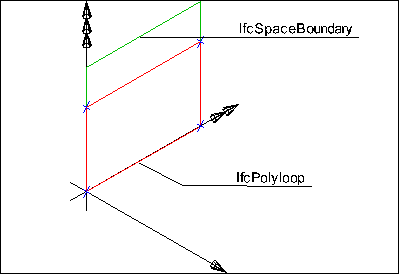 |
EXAMPLE Figure 206 illustrates a planar surface representation where the area of IfcCovering is given by an IfcPolyLoop for planar base surfaces (here provided by the IfcRelSpaceBoundary). The implicit planar surface of the IfcPolyLoop shall be identical with the planar surface defined by the IfcRelSpaceBoundary. |
|
Figure 206 — Covering surface planar |
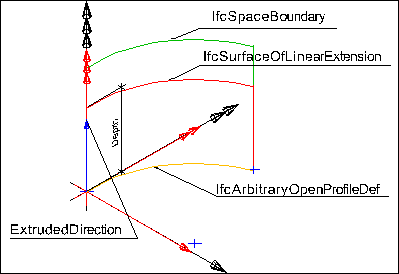 |
EXAMPLE Figure 207 illustrates a cylindrical surface representation where the area of the IfcCovering is given by an IfcSurfaceOfLinearExtrusion for cylindrical base surfaces (here given by the IfcRelSpaceBoundary, such as caused by a round wall).
|
|
Figure 207 — Covering surface cylindrical |
Body SweptSolid Geometry
The Body SweptSolid Geometry concept applies to this entity.
The following additional constraints apply to the 'SweptSolid' representation of IfcCovering:
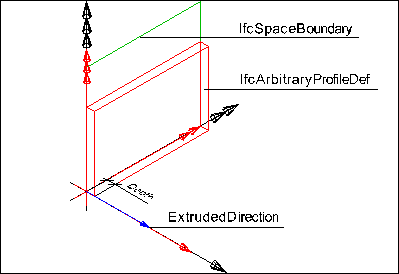 |
EXAMPLE Figure 208 illustrates a body representation where the volume of IfcCovering is given by an IfcExtrudedAreaSolid for planar base surfaces (here given by the IfcRelSpaceBoundary). The extruded area (IfcArbitraryClosedProfileDef) shall be coplanar to the surface defined by the IfcRelSpaceBoundary. |
|
Figure 208 — Covering body planar |
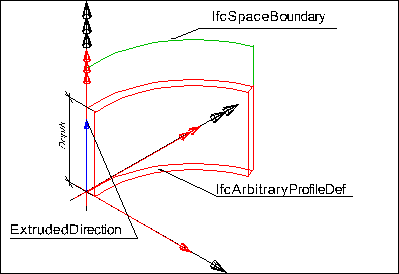 |
EXAMPLE Figure 209 illustrates a body representation where the volume of the IfcCovering is given by an IfcExtrudedAreaSolid for cylindrical base surfaces (here given by the IfcRelSpaceBoundary - such as caused by a round wall).
|
|
Figure 209 — Covering body circular |
| # | Concept | Model View |
|---|---|---|
| IfcRoot | ||
| Software Identity | Common Use Definitions | |
| Revision Control | Common Use Definitions | |
| IfcObject | ||
| Object Occurrence Predefined Type | Common Use Definitions | |
| IfcElement | ||
| Product Local Placement | Common Use Definitions | |
| Box Geometry | Common Use Definitions | |
| FootPrint Geometry | Common Use Definitions | |
| Body SurfaceOrSolidModel Geometry | Common Use Definitions | |
| Body SurfaceModel Geometry | Common Use Definitions | |
| Body Tessellation Geometry | Common Use Definitions | |
| Body Brep Geometry | Common Use Definitions | |
| Body AdvancedBrep Geometry | Common Use Definitions | |
| Body CSG Geometry | Common Use Definitions | |
| Mapped Geometry | Common Use Definitions | |
| Mesh Geometry | Common Use Definitions | |
| IfcBuildingElement | ||
| Product Assignment | Common Use Definitions | |
| Surface 3D Geometry | Common Use Definitions | |
| IfcCovering | ||
| Object Typing | Common Use Definitions | |
| Property Sets for Objects | Common Use Definitions | |
| Quantity Sets | Common Use Definitions | |
| Spatial Containment | Common Use Definitions | |
| Material Layer Set Usage | Common Use Definitions | |
| Material Profile Set Usage | Common Use Definitions | |
| Surface Geometry | Common Use Definitions | |
| Body SweptSolid Geometry | Common Use Definitions | |
<xs:element name="IfcCovering" type="ifc:IfcCovering" substitutionGroup="ifc:IfcBuildingElement" nillable="true"/>
<xs:complexType name="IfcCovering">
<xs:complexContent>
<xs:extension base="ifc:IfcBuildingElement">
<xs:attribute name="PredefinedType" type="ifc:IfcCoveringTypeEnum" use="optional"/>
</xs:extension>
</xs:complexContent>
</xs:complexType>
ENTITY IfcCovering
SUBTYPE OF (IfcBuildingElement);
PredefinedType : OPTIONAL IfcCoveringTypeEnum;
INVERSE
CoversSpaces : SET [0:1] OF IfcRelCoversSpaces FOR RelatedCoverings;
CoversElements : SET [0:1] OF IfcRelCoversBldgElements FOR RelatedCoverings;
WHERE
CorrectPredefinedType : NOT(EXISTS(PredefinedType)) OR
(PredefinedType <> IfcCoveringTypeEnum.USERDEFINED) OR
((PredefinedType = IfcCoveringTypeEnum.USERDEFINED) AND EXISTS (SELF\IfcObject.ObjectType));
CorrectTypeAssigned : (SIZEOF(IsTypedBy) = 0) OR
('IFCSHAREDBLDGELEMENTS.IFCCOVERINGTYPE' IN TYPEOF(SELF\IfcObject.IsTypedBy[1].RelatingType));
END_ENTITY;